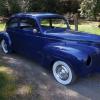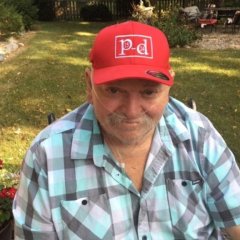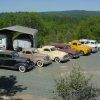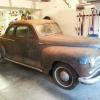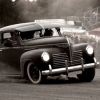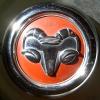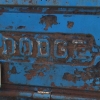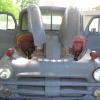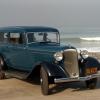Leaderboard
Popular Content
Showing content with the highest reputation on 08/02/2016 in all areas
-
Just got this issue today and it has 2 mopar articles, an in depth feature on the 1951/52 Chrysler Saratoga and a photo feature on a 1953 Plymouth Cranbrook Convertible...........however Pilothouse Truck fan and Oz De Soto pickup owner DeSotoDav has his vehicle pictured in a short letter from an Oz contributor as a followup to the Pilothouse article in the June issue..........GO DAV!!!!!.............lol........andyd3 points
-
Just returned from a few days cruising with mrwstory and his crew in the 40 sedan (more pictures and a write up coming later) and saw this photo opportunity and thought it would fit well with the pictures that have been posted by 1940plymouth. This is the closest I can find to a covered bridge, I think it might have been a railway bridge at one time located in Keremeos BC.3 points
-
Anybody remember this '54 F-88 Roadster concept? http://www.conceptcarz.com/view/photo/312675,11139/1954-Oldsmobile-F-88-Concept_Photo.aspx "Harley Earl, the legendary automotive stylist, designed the F-88 under the belief that it would have outsold the Corvette and forever changed automotive history. Unfortunately Chevrolet, which produced more GM products than any of its other divisions, convinced the GM board of directors to cut the Oldsmobile project. The F-88 never went into production due to that sabotage combined with lukewarm Corvette sales. The 1954 Oldsmobile F-88 was strictly ever a dream car. Meant to compete with the similarly sized Corvette, the F-88 was one of the most significant concept vehicles ever designed by GM. Lightweight; the F-88 would have outperformed even the Ford Thunderbird. The Oldsmobile F-88 featured a Rocket 88 V8, 4 speed automatic hydromatic transmission, power windows and door latches, bullet tail lights, large vertical exhaust outlets for its ‘Rocket' V-8, and a distinguished wide-mouth grille, unlike the Corvette, which only had a 6-cylinder engine, a 2-speed automatic transmission and no windows."2 points
-
Thanks for the heads-up AndyD, and the well wishes from others. I wrote an article on my blue 52 truck "Ernie" and supplied it to the magazine editor (David ) earlier this year. There was a full version of this article in the July issue of Retroautos (pages 45-57)... https://issuu.com/retroautos . David informed me that he intended to run the article in a few magazines, but other magazines had requirements which would require the article to be modified. I am well pleased with how the story came out and can only hope that my effort can generate more interest in these old MOPAR trucks. I most look forward to the 1st May 2017 as I will be travelling down the Coast to take the original owner (Ernest) of the blue 52 truck for a drive to celebrate his 100th birthday.2 points
-
2 points
-
The 1st series 1949 models were an invention of the marketing people, thus they do not appear in any parts book, services manual or serial number listing that came from the Engineering Department. The delay in getting the 1949 models in production had nothing to do with a strike but problems in getting the new models to suit Chrysler head, K. T. Keller. The first models shown to management in 1946 were lower and appeared longer than the production 1949's. I suspect they failed the hat and milk jug tests. K T Keller would walk into the styling department with his hat and a milk jug (the large ones farmers used to take to town). He would sit in the front seat wearing his hat and bounce around. If his hat hit the ceiling, the roof had to be raised. And he then would place his milk jug in the trunk and close the lid. If it closed, excellent. If not the trunk lid had to be raised. But you cannot just raise the roof and raise the trunk lid - the rest of the car has to be changed to match the alterations. Thus the delay in getting the real 1949s into production. And you now know why Chrysler products looked so high and boxy during the Keller era. Production started on the 1st series 1949 models on December 1, 1948, and continued to the end of production in late January, 1949. There are some lists out there that show cars being "produced" in February and March, 1949. But those lists are "SHIPMENTS" reports, not production. With the new models in production, it became difficult to get rid of the now old cars. Thus cars were sitting around Chrysler factories two or three months after they were built. The first series 1949 models were identical to the 1948 versions. You need to know the serial number to tell the difference. Also, engine numbers were a continuation from 1948, which were continued from 1947 and 1946 before that. Just like the cars. 1st series 1949 models apply only to cars, not trucks.. Should point out that Chrysler of Canada did not have a 1st series 1949. They continued to build 1948 models to the end of December and then shut it all down. The Windsor car plant sat idle for January and began building the new 1949 models in February. Sales apparently were tailing off in 1948 and they pulled the plug earlier than in the U.S. The 1st series 1949 models began at the following serial number points : Plymouth DeLuxe - P15S Detroit (Lynch Rd) - 15,284,535 Los Angeles - 26,017,026 Evansville - 22,071,867 Plymouth Special DeLuxe - P15C Detroit (Lynch Rd) - 12,066,020 Los Angeles - 25,062,783 Evansville - 20,287,572 Dodge DeLuxe - D24S / Custom - D24C Detroit (Hamtramck) - 31,201,087 San Leandro - 45,041,546 DeSoto Taxi (LWB) - S11 Detroit (Wyoming Ave) - 5,113,458 DeSoto DeLuxe - S11S Detroit (Wyoming Ave) - 6,205,976 DeSoto Custom - S11C Detroit (Wyoming Ave) - 5,948,453 Los Angeles - 62,001,895 Chrysler Royal Six - C38S Detroit (East Jefferson) - 70,037,181 Chrysler Windsor Six - C38W Detroit (East Jefferson) - 70,702,448 Los Angeles - 67,001,921 Chrysler Town & Country Six - C38W No production after November 30, 1948 Chrysler Saratoga Eight - C39K Detroit (East Jefferson) - 6,770,181 Chrysler New Yorker Eight - C39N Detroit (East Jefferson) - 7,085,470 Chrysler Town & Country Eight - C39N Detroit (East Jefferson) - 7,408,110 Chrysler Crown Imperial Eight - C40 Detroit (East Jefferson) - 7,811,3481 point
-
Although Chrysler Canada built some DeSoto Trucks for export, they were never sold in Canada. Dodge-DeSoto dealers sold Dodge Trucks and Chrysler-Plymouth dealers Fargo Trucks, at least from 1936 through 1972. For 1973 Chrysler-Plymouth dealers started selling Dodge Trucks instead of Fargo. They still build DeSoto trucks in Turkey, by the way, although the company that builds them is not connected to Chrysler. .1 point
-
I suggest you put it back together, get it running, and them make the decision on what to do based on how it runs.1 point
-
I had a good chat with one of the guys at Andy Bernbaum this morning. He said the bigger transmission with the 1 3/8" spline most likely came from a bigger truck, like a 1 ton. That makes sense to me because it is such a significantly bigger and beefier transmission than the 3 speed extra one I have that I know came out of the truck originally. The 3 speed spline is the exact same size as my P15 transmission and should fit right in with the new clutch and pressure plate I have for it already. I'm thinking it would be worth investigating the 3 speed to see how it is mechanically and use it if it's good.1 point
-
I got to work on the steering since the last post and i thought i'd post a little update. First i went to the imperial owners club website and printed the manual. Second i checked the orientation of the steering column in it's mounting boss unter the dash, and found that i had not put a rubber cushion in there yet. i made one from an old tire tube and put it in between the column and the mount. since that changed the angle of the column a little bit i loosened the steering box on the frame to release the tension, tightened the column mount and then tightened the realigned box back to the frame. Then i drained the oil out of the steering and started with checking the end play and bearing preload of the worm and steering tube assembly. i found the new bearing race to be 1/10th of a mm taller than the old one, so i inspected the old bearing and race, diagnosed "mint condition" and put it back in. Afterwards the steering already turned a little easier, and i think it doesn't have any end play in the stering tube, so i guess this is done now. @jdluxuryliner: apparently that's what the #37 shims are all about, to set the correct bearing preload. they do not seem to change the position of the worm in the housing, so the "middle" is strictly defined by the position of the cross shaft head, it seems. Next was to pull the cross (or sector) shaft and roller assembly out of the housing to check the gear mesh again, since the steering was still "binding" a little in the middle. I pulled off the pitman arm and pushed the shaft out to the top. Last time i had taken 2 shims out, so i put one back in and reassembled. From what i can see in the manual, it should be correct now. It's not 100% the exact same steering box in there like i have here, but the functioning principals should be identical. Here's what the manual says about it: this is my steering gears, turned hard to the left. that's where the play is: this is center position. no play and not binding, now that i adjusted the depth of gear mesh correctly: and, finally, hard to the right. there's the play again. from what i see in the manual, it's actually seems to be a good sign that the difference is so noticable, it seems to mean my roller and worm gear are in pretty decent shape. i will fiddle and double check some more, then fill it up again and close it. as soon as the car is back together (hopefully in 2-3 weeks) i can take it for a test spin and see how it works. hope i finally got it to work right now1 point
-
Update: in a couple days I will reinstall the brake master cylinder and pedals. Others have gutted the stock MC and extended the push rod to work a Cherokee dual chamber MC. I believe I can fab a mount to mate the two cylinders but a picture of how someone has already designed one would be greatly appreciated.1 point
-
Dodge Truck had a manufacturing plant right down the road from Disneyland...1 point
-
Nice find! Clearly this was a major project at a time when our trucks were still young and working hard. The construction is pretty well documented with photos and our trucks were definitely there. Wouldn't it be a kick if one of the trucks found in the photos was still around and the current owner a member here? Here is another one.1 point
-
I am going to give you my experiences with the Aerostar springs, which I just completed over the weekend. But first a background on my car. 52 Plymouth bus coupe. 15 x7 cop rims, 215 70 15 tires. No front sway bar, Monroe gas shocks all around. I started messing with the suspension by installing new ESPO 8 leaf springs. Originals were 7 leaf. I opted to leave the 8th leaf in place to see what the result would be. After install the rear sat a little higher than the front, maybe 1-2 inches. Car sat level before the new leaf springs. Upon test driving the front end became even more prone to sway and so on than before - I imagine the stiffer rear was putting more downforce on the front springs. Next step was to do the aerostar springs on the front. I have no experience with swapping coil springs. Every car I've messed with are 60 or 70's mopars with torsion bar front ends. So this was a little bit of a concern on my part as to what to expect. Well, I have to say swapping coil springs was one of the easiest things I've done so far on this car. Literally took 30 minutes to get a spring out. I chose to remove the lower control arm for cleaning and repainting. Just keep the the pivot bar in its original orientation if u do this. So as a result my swap instead of being a 2 hour job was 8 hours..but now I have nice clean front end parts ! After install the test drive exhibited a great improvement in ride, and handling. The car does not dive and sway is greatly reduced. As to ride height, the front end is now about 1 inch higher than it was after the new leaf springs were installed. Overall the car is back sitting dead level but maybe 1-1.5 inches taller than it was originally. Bottom line - for those of you considering the stock OEM style springs - Forget it. Buy the Aerostar springs, be happy, enjoy the vastly improved ride/handling, and put the 150-200 bucks you saved towards something else. Next, I plan on installing a sway bar. But that won't happen for a month or so. Relocating the upper front shock mount is on the list too. Now for a question - as I said, I have no experience with coil springs. I have heard that coil springs will "settle" meaning the front will drop a little after install. Can anyone tell me if that is a true statement, and if so, how much do they drop ? Is the settling something that is affected by driving or can it happen just by sitting still ?1 point
-
1 point
-
1 point
-
Brent, Thanks for posting #8 above a few years ago on www.amkproducts.com. While I have about 8 original J-Nuts that I could clean up like the one in my photos I found it simpler for me to just buy all new ones. I tested them out on my fenders, floor pan, and the cowl where the center hood section connects and they fit in all areas easily. I liked that the new ones are stamped T 56-24 just like the original ones. Phil1 point
-
Hmmm. Take an Australian's explanation of Australian slang or an American's explanation. Decisions, decisions, decisions. . .1 point


